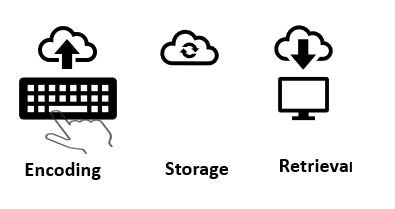
To understand diamonds, you need to know about their four qualities:
Cut, Carat, Clarity, and Color--what
jewelers would call the 4 C's of diamonds.
To understand memory systems, you need to
know
about their three qualities: Encoding
(coding information into memory), Storage
capacity (memory
size and duration), and Retrieval (recovering)--what you could--but
shouldn't--call the 3
c's of memory:*
*If you did call Encoding, Storage, and Retrieval "the 3 c's," how would you remember what the 3 terms are really called? Besides, what would people think? Probably that you are no different from those who talk about the 3 K's: Kapturing, Keeping, and re-Kollecting--except that you can spell.☺
The 3 Key Terms Defined:
To help you understand what Encoding, Storage, and Retrieval are and to help you remember that they are memory's 3 active and independent processes, watch this short (26 second) animation.
Point not to overlook when focusing on memorizing definitions of each of the 3 processes: Rather than viewing your memory as just a storage space, realize that storing information is just 1 of 3 active processes that make up what we call memory. So, memory is more than an information warehouse.
Point that often trips up students: The 3 key qualities are independent--being good at one doesn't mean the memory is good at another. For example, a memory that has good storage capacity will not necessarily be good at retrieval. To see why, imagine two memories--one that is like a shoe box, and one that is like a poorly organized attic. The shoe box memory would be bad at storage (not much could be stored) but would be great at retrieval (if something is in the shoe box, it would be easy to find). The messy attic memory, on the other hand, would be great at storage (lots of stuff could be dumped in there) but would be poor at retrieval (it would be hard to sort through all the junk scattered throughout a dark, messy attic to find the one thing you needed). To reiterate, just as knowing a diamond's size doesn't tell you about its clarity, knowing that a memory has good sized storage space doesn't tell you that the memory is good at retrieval.
Take home lesson: If you are having a problem remembering names, class material, or some other information, the first step to solving that problem is to figure out which memory process is failing you. You may be able to pinpoint the source of your problem by asking 3 questions:
Take a short (just 4 multiple-choice questions) quiz over encoding, storage, and retrieval.
Learn about your 3 memories: The 3 Box Model Copyright 2020-2025 Mark L. Mitchell